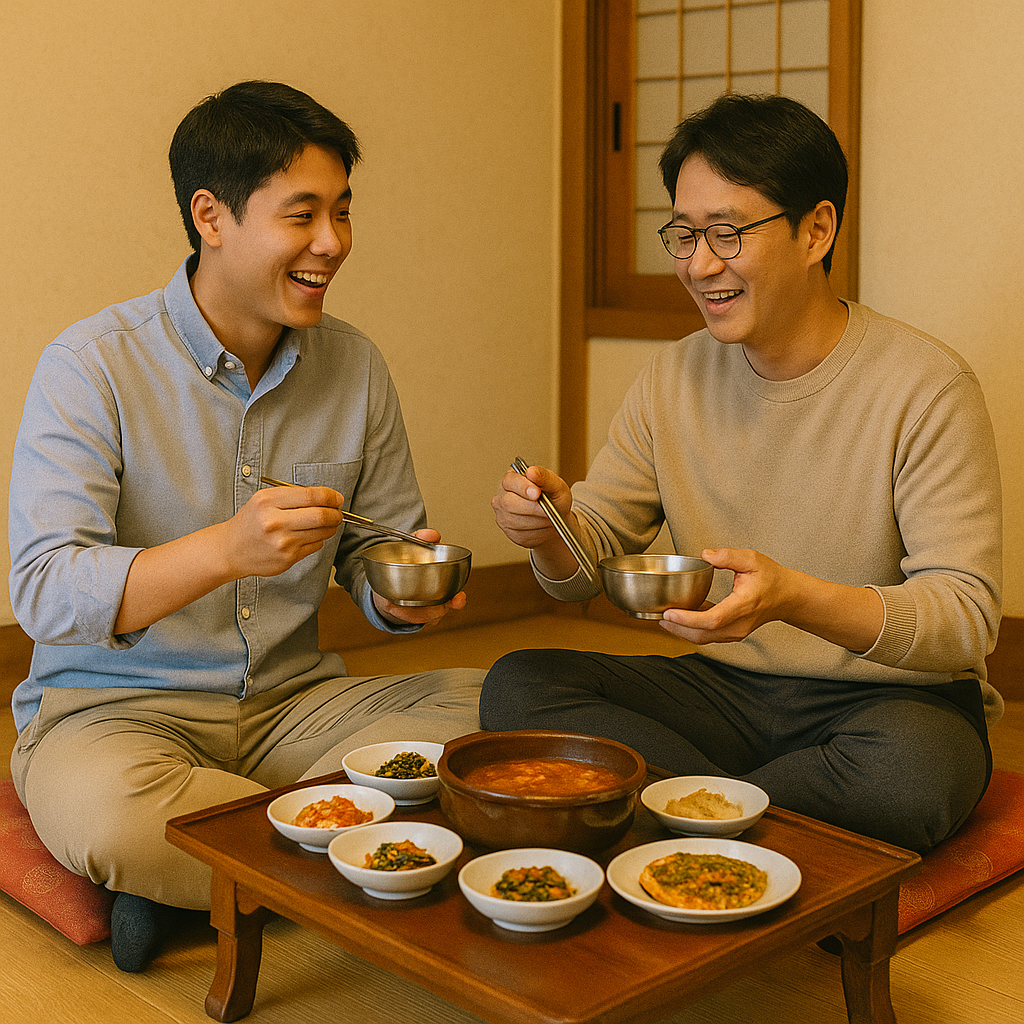Ever noticed how Koreans often choose to sit side-by-side, even during intimate conversations or dates? This subtle habit reflects deeper cultural values that go beyond mere comfort.
In Korean society, the way people sit—especially in social and public settings—reveals underlying principles of harmony, respect, and practicality. From traditional ondol rooms to modern cafés, sitting side-by-side is more than just a physical arrangement—it's a cultural expression.

Why is direct eye contact often avoided in Korean culture?
In Korean interactions, maintaining strong eye contact can be perceived as confrontational or overly assertive. Sitting side-by-side naturally reduces this pressure, allowing for more relaxed and honest communication. This is especially true in hierarchical or emotionally sensitive situations, where avoiding direct confrontation is key to social harmony.
How traditional floor culture shaped modern seating habits
Historically, Koreans sat on heated floors (ondol) in close-knit communal settings. Chairs were uncommon, and sitting in lines allowed for better space usage and easy sharing of meals. This practice continues to influence today's habits, even when sitting on benches or in cafés, where the preference for side-by-side seating persists.
What role does Confucian respect play in seating etiquette?
Confucian values emphasize social order and respectful distance. Sitting side-by-side avoids placing someone directly opposite a superior or elder, which could be seen as disrespectful. This arrangement helps maintain proper decorum while enabling conversation in a non-challenging environment.
Why is side-by-side seating still common in modern spaces?
In cafés, study rooms, and classrooms, sitting side-by-side is more practical for shared screens, collaborative work, or joint reading. It also fosters a sense of togetherness without the pressure of direct interaction—ideal for both romantic and platonic settings in contemporary Korea.
Conclusion: A seating style that reflects culture
Side-by-side seating in Korea is more than just tradition—it's a reflection of deeper social principles. It supports harmony, shows respect, and adapts to both traditional and modern contexts with ease. Understanding this habit offers a meaningful glimpse into how cultural values shape even the smallest daily actions.
한국인들이 친밀한 상황에서도 마주보지 않고 나란히 앉는 이유가 궁금하셨나요? 이 사소한 습관 뒤에는 단순한 편안함을 넘어선 깊은 문화적 가치가 숨어 있습니다.
한국 사회에서 사람들의 좌석 배치는 조화, 존중, 실용성이라는 핵심 가치와 밀접하게 연결되어 있습니다. 전통 온돌방에서부터 현대의 카페에 이르기까지, 나란히 앉는 것은 단순한 배치가 아닌 문화적 표현입니다.

왜 한국에서는 눈을 마주치는 걸 피할까?
한국 문화에서는 강한 눈맞춤이 대립적이거나 지나치게 자신감 있는 태도로 보일 수 있습니다. 나란히 앉는 것은 이런 부담을 줄이고, 보다 편안하고 솔직한 대화를 가능하게 합니다. 특히 감정적인 상황이나 위계가 있는 관계에서는 직접적인 대립을 피하는 것이 중요한데, 이 방식이 그 역할을 합니다.
바닥 문화가 현대 좌석 습관에 미친 영향은?
한국의 전통 가옥은 온돌 구조로, 사람들이 바닥에 앉아 함께 식사하고 대화하는 문화가 형성되었습니다. 이때 나란히 앉는 것이 공간 활용과 소통에 가장 효율적이었고, 이러한 습관은 오늘날 의자가 있는 공간에서도 계속 이어지고 있습니다.
유교적 예절이 좌석 배치에 어떤 영향을 줄까?
유교 문화에서는 질서와 예의가 중요하게 여겨집니다. 나란히 앉는 것은 상급자나 연장자와 마주보며 앉는 부담을 피하고, 적절한 거리감을 유지하는 방식으로 존중을 표현할 수 있습니다. 대화는 가능하지만 대립은 피하는 섬세한 사회적 규범입니다.
현대 공간에서도 나란히 앉는 이유는?
카페, 스터디 공간, 교실 등에서는 나란히 앉는 것이 실용적인 이유가 많습니다. 함께 화면을 보거나 자료를 검토할 때 훨씬 효율적이고, 직접 마주보지 않아도 정서적 연결을 유지할 수 있기 때문에 데이트나 친구 사이에서도 자주 활용됩니다.
결론: 문화가 반영된 좌석 배치
한국의 나란히 앉기 문화는 전통을 넘어 현대에도 그대로 이어지며, 사회적 조화, 존중, 효율성을 모두 반영하는 좌석 방식입니다. 이 작은 행동을 이해하는 것은 한국 문화를 깊이 이해하는 데 중요한 단서가 됩니다.